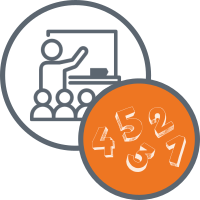CDE will be closed on Monday, Jan. 20 for the Martin Luther King, Jr. holiday.
You are here
Effective Mathematics Teaching Practice 7: Support Productive Struggle in Learning Mathematics
Instructional Support Menu
Support Productive Struggle in Learning Mathematics
Productive struggle is as much a goal of NCTM’s Effective Mathematics Teaching Practices as it is a practice itself. Struggle in mathematics is easy to find, but what makes it productive is that feeling of making sense of things, of seeing relationships between quantities or shapes, and making progress towards a strategy that may yield a viable solution, and, more importantly, a better understanding of the underlying mathematics. Letting students find this place of productive struggle, and to stay there for a while, often takes more patience and restraint than teachers are accustomed to having. This is why the other Effective Teaching Practices are so important—teachers are unlikely to position students for engaging in productive struggle unless they’re focused on the right goals, they’ve chosen the right tasks, they facilitate meaningful discourse, they ask purposeful questions, they encourage a range of representations, and they strategically make use of evidence of student thinking. When the teacher establishes the right conditions for student learning, it becomes far more likely that students will persist rather than give up, take risks without fear, and persevere when the work becomes challenging.
Effective teaching of mathematics consistently provides students, individually and collectively, with opportunities and supports to engage in productive struggle as they grapple with mathematical ideas and relationships.
-NCTM (2014), p. 48
The Practice in Action
One of the ways NCTM (2014, p. 52) summarizes the practice of support productive struggle in learning mathematics is by describing a set of actions expected of teachers and students that indicate engagement in this teaching practice.
Caution! Don't over-estimate your own understanding based on these brief descriptions of teaching practice. Professional educators should dig more deeply into NCTM's resources, join study groups and professional networks, and seek out professional development and coaching to ensure high-quality engagement in the practice.
What are teachers doing?
- Anticipating what students might struggle with during a lesson and being prepared to support them productively through the struggle.
- Giving students time to struggle with tasks, and asking questions that scaffold students’ thinking without stepping in to do the work for them.
- Helping students realize that confusion and errors are a natural part of learning, by facilitating discussions on mistakes, misconceptions, and struggles.
- Praising students for their efforts in making sense of mathematical ideas and perseverance in reasoning through problems.
What are students doing?
- Struggling at times with mathematics tasks but knowing that breakthroughs often emerge from confusion and struggle.
- Asking questions that are related to the sources of their struggles and will help them make progress in understanding and solving tasks.
- Persevering in solving problems and realizing that is acceptable to say, “I don’t know how to proceed here,” but it is not acceptable to give up.
- Helping one another without telling their classmates what the answer is or how to solve the problem.
Resources
- Principles to Action: Ensuring Mathematical Success for All (2014, pp. 48-52)
- Taking Action: Implementing Effective Mathematics Teaching Practices in K-Grade 5, pp. 213-241
- Taking Action: Implementing Effective Mathematics Teaching Practices in Grades 6-8, pp. 169-192
- Taking Action: Implementing Effective Mathematics Teaching Practices in Grades 9-12, pp. 183-211
- Enhancing Classroom Practice with Research behind Principles to Actions, pp. 73-87




Connect With Us





